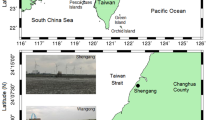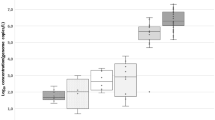Abstract
The white spot syndrome virus (WSSV), the causative agent of white spot disease (WSD) of shrimp, has emerged as a single most critical pathogen causing severe epizootics, inflicting significant economic loss to the global shrimp aquaculture industry. It can be transmitted vertically from infected broodstock to post-larvae and horizontally by cannibalism, invertebrate carriers, water, and sediment. Shrimp pond sediment represents an important reservoir of WSSV. The viability of WSSV in sediment is the most vital parameter in the transmission of WSD in the freshly stocked ponds. The physicochemical properties of sediment influence the viability and infectivity of WSSV. The objective of this study was to determine the viability of WSSV with reference to the physicochemical properties of pond sediment under farm conditions. The viability of WSSV in sediment samples from three WSSV-affected ponds with different soil types was examined using polymerase chain reaction (PCR), quantitative PCR, and infectivity studies. The soil characteristics, such as texture, pH, organic carbon (OC), electrical conductivity (EC), and moisture content were examined to unravel their relationship with the viability of WSSV. The WSSV could be detected in these shrimp pond sediments by PCR up to 35 to 52 days. However, it was revealed that the WSSV was infective up to 21 and 32 days in sandy clay loamy soil and 25 days in sandy loamy soil, suggesting the infectivity of WSSV was prolonged in sandy clay loamy soil. Further, the viability of WSSV was found to be dependent on the moisture content of the pond sediment and independent of organic carbon, pH, and electrical conductivity. These observations reinforce the adoption of best management practices (BMPs) like sun-drying of ponds for at least 3–5 weeks between the crops to achieve biosecurity and ensure successful culture.









Similar content being viewed by others
References
Armanious A, Aeppli M, Jacak R, Refardt D, Sigstam T (2016) Viruses at solid–water interfaces: a systematic assessment of interactions driving adsorption. Environ Sci Technol 50:732–743
Bitton G (1980) Introduction to environmental virology. John Wiley and Sons, New York
Bosch A, Pinto RM, Abad FX (2006) Survival and transport of enteric viruses in the environment. In: Viruses in foods. Springer, Boston, pp 151–187
Breitbart M, Rohwer F (2005) Here a virus, there a virus, everywhere the same virus? Trends Microbiol 13:278–284
Chang PS, Chen LJ, Wang YC (1998) The effect of ultraviolet irradiation, heat, pH, ozone, salinity and chemical disinfectants on the infectivity of white spot syndrome baculovirus. Aquaculture 166:1–17
Fauquet CM, Mayo MA, Maniloff J, Desselberger U, Ball LA (2005) Virus taxonomy: VIII report of the International Committee on Taxonomy of Viruses. Academic Press, London
Gerba CP (1983) Virus survival and transport in groundwater. Dev Ind Microbiol 24:247–251
Gerba CP (1984) Applied and theoretical aspects of virus adsorption to surfaces. Adv Appl Microbiol 30:133–168
Gerba CP (2005) Survival of viruses in the marine environment. In oceans and health: pathogens in the marine environment. Springer, Boston MA, pp 133–142
Gerba CP, Bitton G (1984) Microbial pollutants: their survival and transport pattern to groundwater. In: Bitton G, Gerba CP (eds) Groundwater pollution microbiology. John Wiley and Sons, Inc., New York, pp 65–68
Hurst CH, Gerba CP, Cech I (1980) Effects of environmental variables and soil characteristics on virus survival in soil. Appl Environ Microbiol 40:1067–1079
Jackson ML (1973) Soil chemical analysis. Prentice Hall, Englewood Cliffs 452 p
LaBelle RL, Gerba CP (1980) Influence of estuarine sediment on virus survival under field conditions. Appl Environ Microbiol 39:749–755
Li W, Desmarets LM, De Gryse GM, Theuns S, Van Tuan V, Van Thuong K, Bossier P, Nauwynck HJ (2015) Virus replication cycle of white spot syndrome virus in secondary cell cultures from the lymphoid organ of Litopenaeus vannamei. J Gen Virol 96:2844–2854
Lightner DV, Redman RM, Pantoja CR, Tang KFJ, Noble BL, Schofield P, Mohney LL, Nunan LM, Navarro SA (2012) Historic emergence, impact and current status of shrimp pathogens in the Americas. J Invertebr Pathol 110:174–183
Natividad KDT, Nomura N, Matsumura M (2008) Detection of white spot syndrome virus DNA in pond soil using a 2-step nested PCR. J Virol Methods 149:28–34
OIE (2012) White spot disease. Manual of diagnostic tests for aquatic animals. http://www.oie.int/fileadmin/Home/eng/Healthstandards/aahm/2010/2.2.06,WSD.pdf. Accessed 12 March 2013
Piper CS (1966) Soil and plant analysis. Hans Publishers, Bombay
Prescott JA, Taylor JK and Marshall TJ, (1934) The relationship between the mechanical composition of the soil and the estimate of texture in the field. Transactions 1st commission, International Society of Soil Science pp. 143–153
Ritchey EL, McGrath JM, Gehring D (2015) Determining soil texture by feel. Agriculture and Natural Resources Publications, p 139. https://uknowledge.uky.edu/anr_reports/139
Rzezutka A, Cook N (2004) Survival of human enteric viruses in the environment and food. FEMS Microbiol Rev 28:441–453
Satheesh Kumar S, Ananda Bharathi R, Rajan JJS, Alavandi SV, Poornima M, Balasubramanian CP, Ponniah AG (2013) Viability of white spot syndrome virus (WSSV) in sediment during sun-drying (drainable pond) and under non-drainable pond conditions indicated by infectivity to shrimp. Aquaculture 402-403:119–126
Sobsey MD, Shields PA, Hauchman FH, Hazard RL, Caton LW (1986) Survival and transport of hepatitis A virus in soils, groundwater and wastewater. Water Sci Technol 18:97–106
Walkey A, Black IA (1934) An examination of Degtjareff method for determination of soil organic matter and a proposed modification of the chromic acid titration method. Soil Sci 37:29–38
Yan DC, Dong SL, Huang J, Yu XM, Feng MY, Liu XY (2004) White spot syndrome virus (WSSV) detected by PCR in rotifers and rotifer resting eggs from shrimp pond sediments. Dis Aquat Org 59:69–73
Yates MV, Yates SR, Wagner J, Gerba CP (1987) Modeling virus survival and transport in the subsurface. J Contam Hydrol 1(3):329–345
Yeager JG, O'Brien RT (1979) Structural changes associated with poliovirus inactivation in soil. Appl Environ Microbiol 38:702–709
Acknowledgments
Authors sincerely thank the shrimp farmers from Tamil Nadu and Andhra Pradesh for providing the samples for this study.
Funding
The authors are thankful to the Department of Biotechnology, Govt. of India, New Delhi, for the financial support for this research work (BT/PR 12833/AAQ/03/484/2009 dated 29th June 2010).
Author information
Authors and Affiliations
Contributions
S.S.K. and R.A.B. collected the samples, carried out the infectivity studies, and analyzed the samples by PCR. J.J.S. carried out the real-time PCR analysis. M.M. planned the relevant environmental parameters of this study. V.C. analyzed the environmental parameters. S.V.A., S.S.K., and J.J.S. wrote the manuscript. All the authors contributed to the analysis and interpretation of the results. S.V.A. conceived, planned, and coordinated the study.
Corresponding author
Ethics declarations
Conflict of interest
The authors declare that they have no conflict of interest.
Ethical approval
All applicable institutional guidelines for the care and use of animals were followed by the authors.
Additional information
Publisher’s note
Springer Nature remains neutral with regard to jurisdictional claims in published maps and institutional affiliations.
Rights and permissions
About this article
Cite this article
S, S.K., Bharathi, R.A., Rajan, J.J.S. et al. Viability of white spot syndrome virus (WSSV) in shrimp pond sediments with reference to physicochemical properties. Aquacult Int 27, 1369–1382 (2019). https://doi.org/10.1007/s10499-019-00394-2
Received:
Accepted:
Published:
Issue Date:
DOI: https://doi.org/10.1007/s10499-019-00394-2




